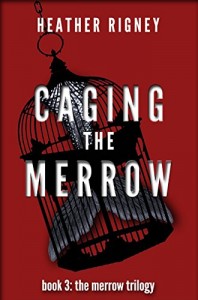 I’ve been both anticipating and dreading the arrival of this book. I was a huge fan of the first two books in The Merrow Trilogy (Waking the Merrow and Hunting the Merrow), and couldn’t wait to read how the story was going to end. On the flipside, I was coming to grips with the fact that this is (probably) the last I will know of this eccentric and lovely cast of characters. Love or hate them, I became enthralled with each of them, their own individual stories and the current story they are all connected to. This was something that I selfishly didn’t want to end.
I’ve been both anticipating and dreading the arrival of this book. I was a huge fan of the first two books in The Merrow Trilogy (Waking the Merrow and Hunting the Merrow), and couldn’t wait to read how the story was going to end. On the flipside, I was coming to grips with the fact that this is (probably) the last I will know of this eccentric and lovely cast of characters. Love or hate them, I became enthralled with each of them, their own individual stories and the current story they are all connected to. This was something that I selfishly didn’t want to end.
Everyday antihero/alcoholic Evie McFagan finds herself in the crisis Hunting the Merrow ended in. She had no clue where her husband (Paddy), child (Savannah) or best friend (Rachel) are, she had (unhappily) reunited with her brother (Richard) and was directly responsible for the capture of Nomia, Nix and Ronan (mermaids and mermen, respectively). Sitting alone in a cell overwhelmed with guilt, she tries to devise a plan to help fix this mess that she inadvertently created, until she discovers that this is all out of her hands and decides that she will abide by her brother’s request to travel to Maine to assure the safety of her husband and child.
Nomia, a prisoner of Samnlung (a place where a great white shark is the least interesting attraction), just learned disturbing news about Richard, her lover and now captor, who is in for a crazy ride. She spends time reflecting on the definition of a monster and the consequences of the actions she tried to take in the name of revenge. Nomia had become a sympathetic character in Hunting the Merrow, and that continues with this book. Though she wants to escape, she mostly wants to save her sister. She makes some sideshow friends who agree to help her. She also learns more about her origins from Cliodhna, owner of Samnlung and the one who paid Richard to capture her.
Cliodhna is the main antagonist, but her story (minus her initial conversation with Nomia) starts with a heartbreaking origin that builds immediate sympathy for her. She is evil, but the reason for her evil is understandable. I tried to hate her, but she’s fascinating and has been through so much that I just couldn’t help but (sort of) root for her (at least until the end).
Herein lies the strength of Heather Rigney. She has the uncanny ability to create characters who are sympathetic, lovable, chock full of flaws, evil, funny and real (these simple descriptive words don’t nearly do her character development justice). The adventures her players go through are great, but it’s the cast I fell in love with. Even the minor and seeming insignificant characters (Ephron is the best example) are well thought out, giving a full glimpse into who they are. It is clear that she spent significant time on character development, and it pays off. I would gladly read a full novel about each individual.
Caging the Merrow has a huge cast and a lot going on. The story jumps around from character to character instead of being linear, following the same path of Hunting the Merrow. I enjoyed this approach and got excited reading how everything was going to come together. Rigney set everything up nicely for the pummeling finale. No questions were left unanswered and the climax, while not what I was expecting, was incredibly exciting. The last scene was a fitting ode to the benefits of strong friendships, while leaving me craving a doughnut.
Rigney has struck gold with all three books of The Merrow Trilogy. She has created some of the best characters I have read in a long time. More importantly, they became a part of me — fictional people who I developed feelings for, and I was full of emotions as their stories played out. Rigney is not only my favorite Rhode Island author, but also one of my favorite authors in general. She’s right up there with Kurt Vonnegut, Haruki Murakami and Christopher Buckley.

